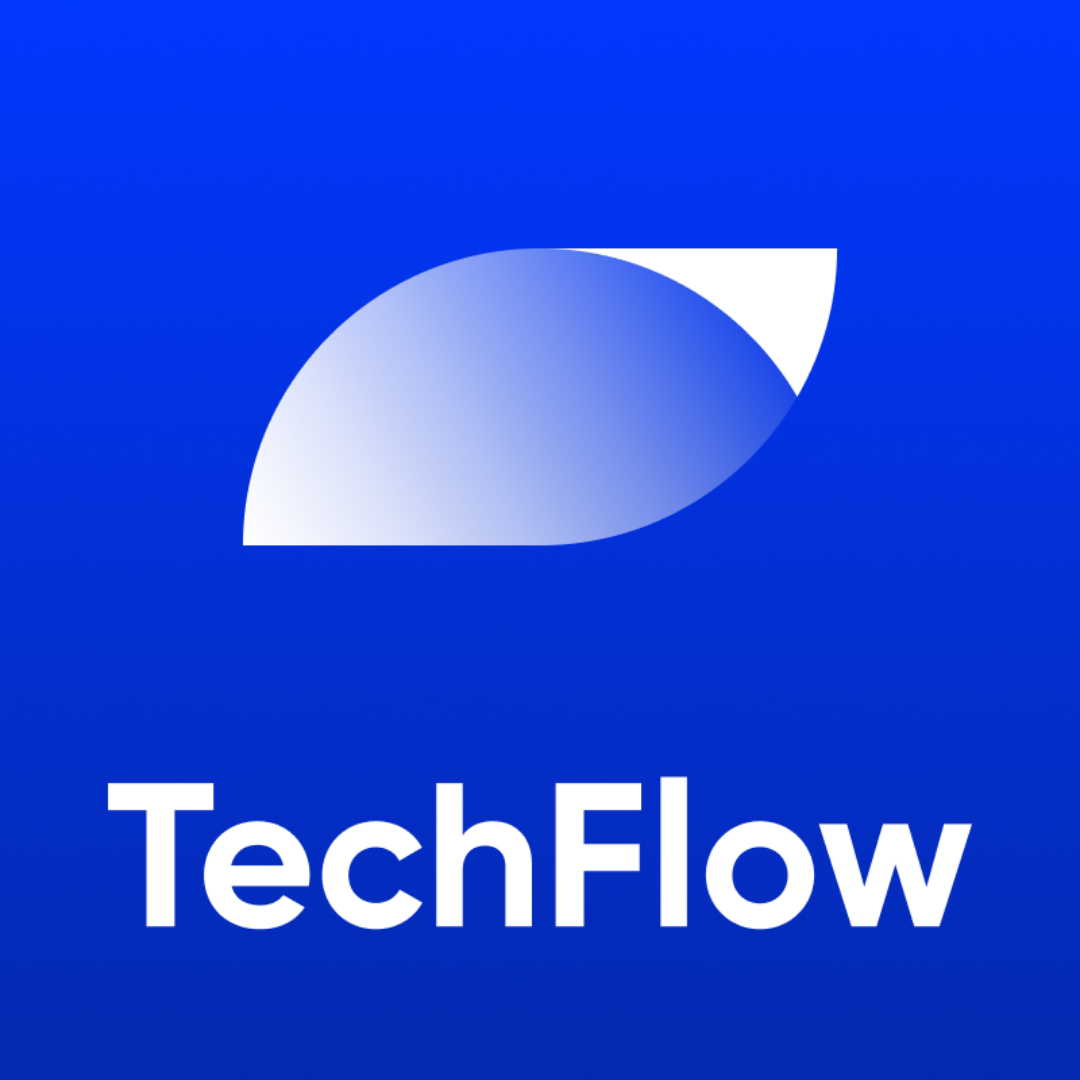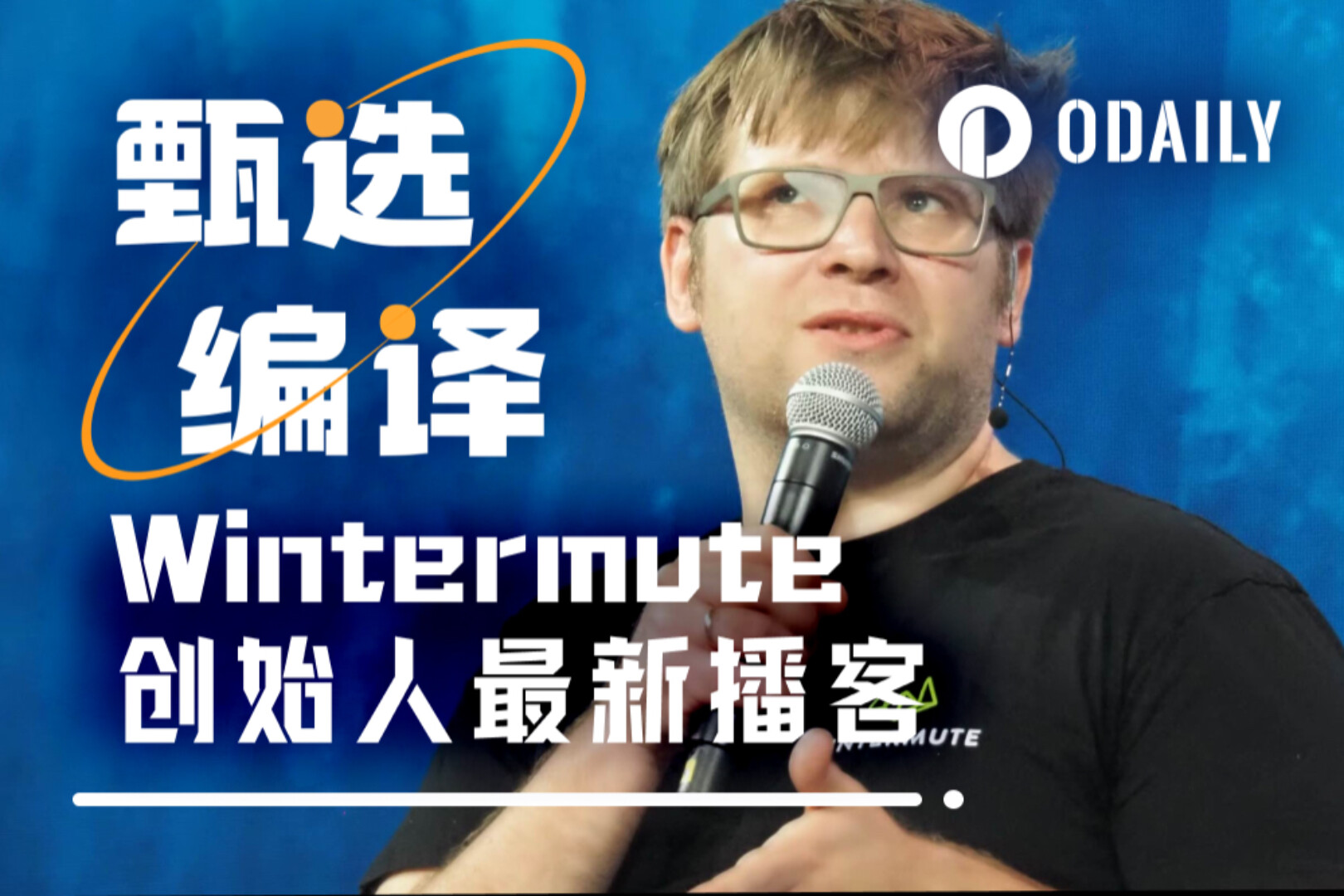Original article by 100y.eth , Four Pillars
Original translation: TechFlow
Key Takeaways
- The highly anticipated Monad mainnet launch is imminent. Monad has garnered significant attention from investors and retail traders for its high-performance EVM-based technology stack. While fully compatible with the EVM, Monad promises to offer a smoother and more scalable user experience.
- Monad, with its cutting-edge technology, is able to support new types of decentralized applications (dApps) that are not possible on other EVM networks. Currently, there are many dApps in the Monad ecosystem, but this article will delve into the dApps that are truly native to Monad.
1. Monad's long-awaited launch
1.1 The Secret of Monad's Popularity
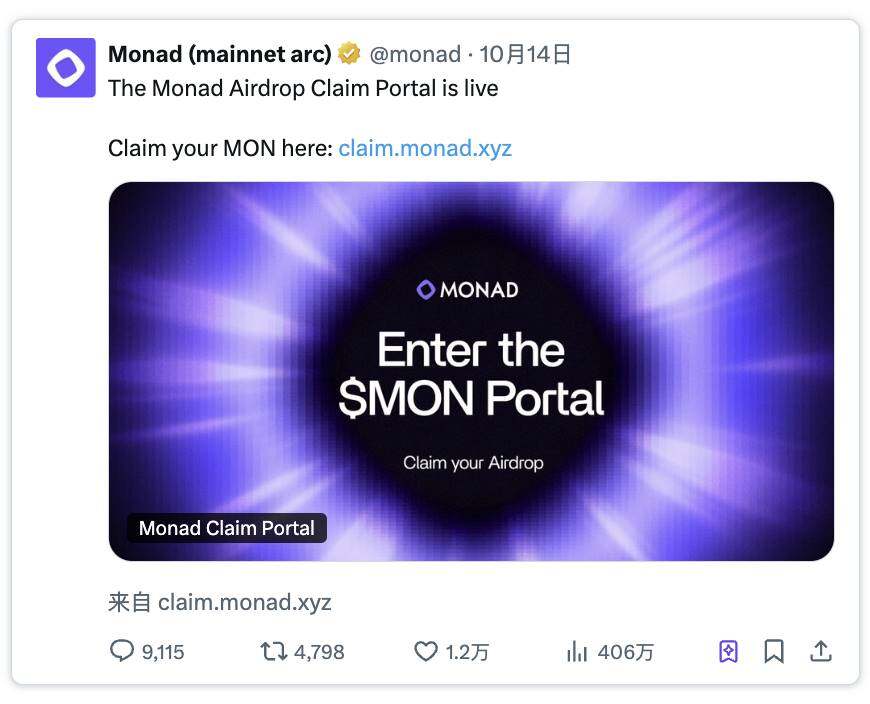
Original tweet link: click here
On October 14th, Monad officially announced the launch of its airdrop claim portal, sparking widespread excitement among users. This wasn't surprising, as Monad had already attracted significant attention when it announced its seed funding round in Q1 2023. However, two and a half years had passed since the seed round, and the mainnet was finally nearing launch.
While Monad's popularity stemmed from a variety of factors, including investment from prominent venture capitalists and a unique community, its core value lay in its technology. At the time, building and implementing a parallel EVM was an ambitious goal, which in itself was enough to attract the attention of investors, the community, and users.
Monad is a high-performance, EVM-compatible L1 network with the following technical features:
- MonadBFT: An optimized Byzantine Fault Tolerant (BFT) consensus algorithm that achieves 10,000 transactions per second (tps) and sub-second finality, even in environments with hundreds of consensus nodes. Unlike traditional BFT systems, MonadBFT only requires a single round of consensus to reach a near-final state.
- RaptorCast (RaptorCast): A method that allows master validators to efficiently transmit large blocks to other validators. The master validator uses erasure coding to split the block proposal into multiple parts, each of which is first sent to non-master validator nodes, which then propagate it further. This reduces the load on the master validator while maintaining security, as erasure coding can even recover data from partial blocks.
- Asynchronous Execution: In most blockchains, consensus and execution are bundled together, which leads to inefficiencies. Monad decouples the two, so nodes first agree on the order of transactions and then execute them, allowing ample processing time.
- Parallel Execution: Monad uses optimistic execution, first processing transactions in parallel and re-executing only those that conflict.
- MonadDb (MonadDb): Unlike Ethereum's structure, MonadDb is based on Merkle Patricia Trie, supports direct access to Trie nodes, asynchronously processes read and write requests, optimizes parallel execution, and supports file system bypass and concurrency control.
Through these core optimizations, Monad achieves exceptional scalability, enabling dApps that are impossible on other EVM networks. Combined with its full EVM compatibility, Monad provides an excellent development environment for developers, enabling them to freely build a wide range of applications without worrying about scalability limitations.
1.2 Monad Ecosystem: Born for Monad
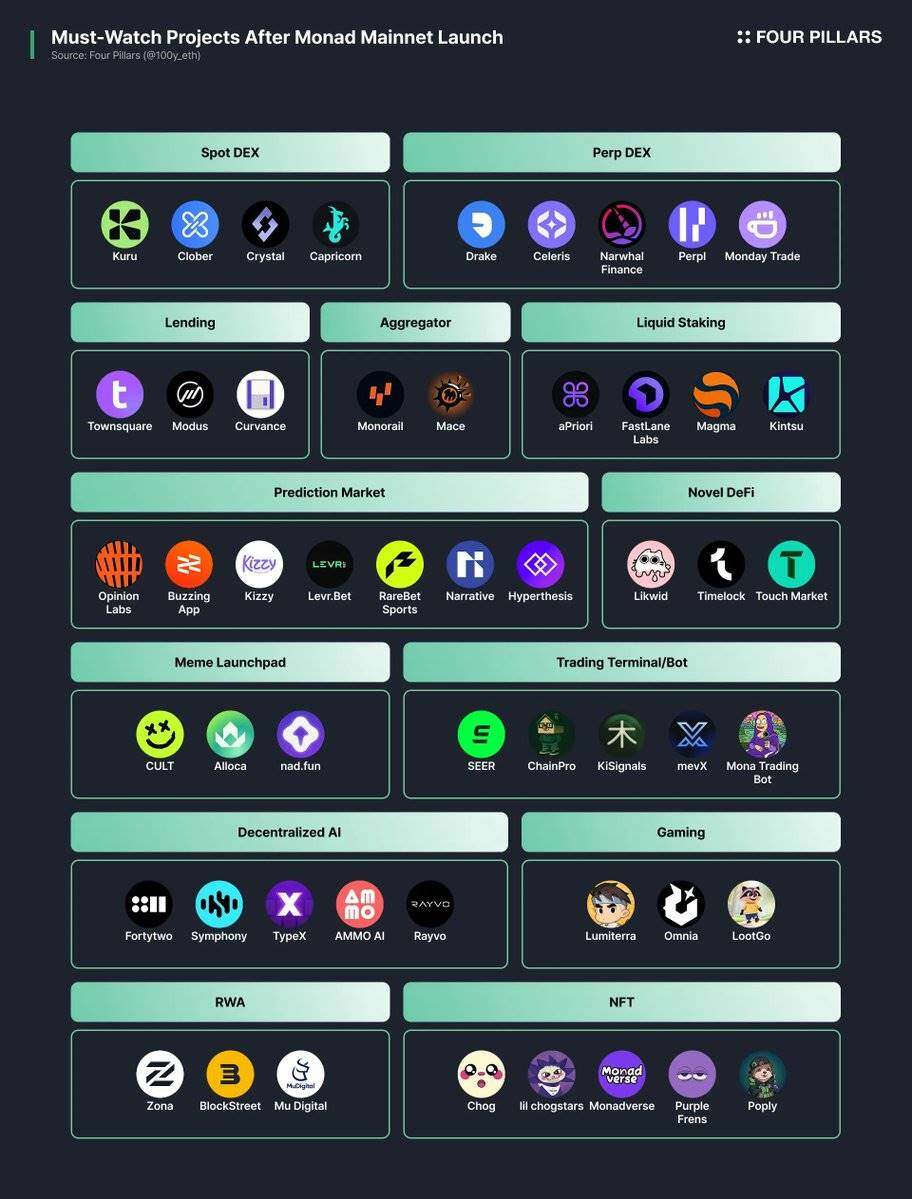
So, with the Monad mainnet about to launch, what services can users expect to see in its ecosystem? As of October 11, 2025, the Monad ecosystem directory lists 293 dApps, including well-known projects such as 0x, Balancer, Euler, Farcaster, Lombard, Magic Eden, OpenSea, Pancake Swap, Stargate, StakeStone, Uniswap, and Wormhole.
However, Monad differs significantly from existing blockchain networks, so we can expect to see many unique and innovative services emerge on the Monad Network. This article will delve into some of the most notable dApps in the Monad ecosystem, as well as the winning projects from the Monad Accelerator Program and Hackathon.
Here’s a quick summary of some noteworthy dApp categories and their representative projects. Readers interested can scroll down for more details:
- Staking : aPriori, FastLane Labs, Magma, Kintsu
- Spot DEX : Kuru, Clober, Crystal, Capricorn
- Perpetual Contract DEX : Drake, Celeris, Narwhal Finance, Perpl, Monday Trade
- Aggregators : Monorail, Mace
- Lending : Townsquare, Modus, Curvance
- New DeFi : Likwid, Timelock, Touch Market
- Prediction Markets : Opinion Labs, Buzzing App, Kizzy, Levr.Bet , RareBetSports, Narrative, Hyperthesis
- Trading terminals/bots: SEER, ChainPro, KiSignals, mevX, Mona Trading Bot
- Meme Coin Launchpad : CULT, Alloca, nad.fun
- Games : Lumiterra, Omnia, LootGo
- Artificial Intelligence : Fortytwo, Symphony, TypeX, AMMO AI, Rayvo
- NFT : Chog, lil chogstars, Monadverse, Purple Frens, Poply
- RWA : Zona, BlockStreet, Mu Digital
2. Noteworthy dApps in the Monad Ecosystem
2.1 aPriori
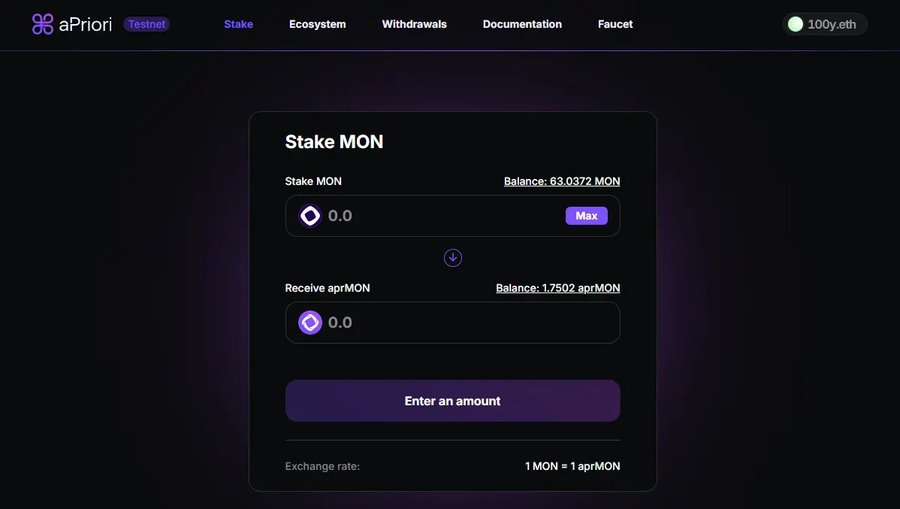
Source: aPriori
aPriori is the most prominent liquidity staking protocol in the Monad ecosystem. Users can stake MON and receive aprMON, a liquidity staking token. aprMON not only earns regular PoS staking rewards but also receives and distributes MEV generated by the network to users.
Due to Monad's high scalability, the network will process a large number of transactions, which naturally creates numerous opportunities for MEV. Unlike the traditional EVM, which processes transactions one by one, Monad EVM utilizes parallel processing, which significantly alters the way MEV is captured. aPriori , understanding this, has developed the concept of probabilistic MEVA.
aPriori secured $2 million in seed funding from Hashed and Arrington Capital in 2023, an $8 million seed round from Pantera, Consensys, and Flow Traders in July 2024, and an additional $20 million in funding from Pantera, HashKey, and IMC Trading in August 2025. This makes it one of the most well-funded dApps in the Monad ecosystem. Users can stake MON on the testnet to obtain aprMON and use it in various DeFi protocols.
2.2 FastLane Labs
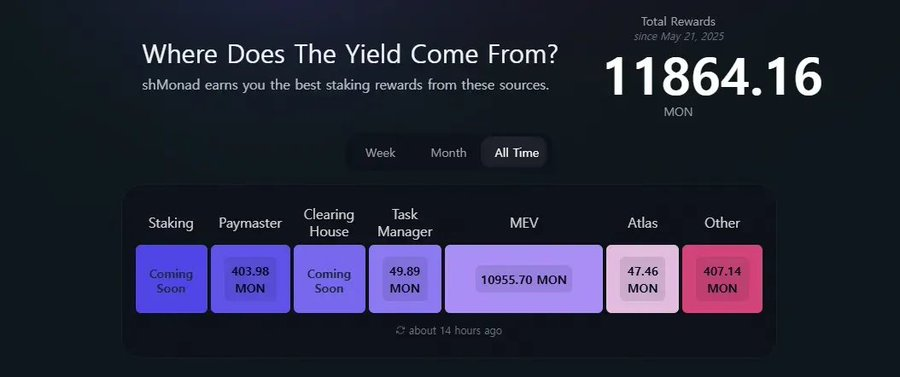
Source: FastLane Labs
FastLane Labs provides staking and MEV-related infrastructure for the Monad ecosystem. Key services include:
- shMONAD : A Monad liquidity staking protocol based on FastLane's MFL and Atlas technology that not only extracts MEV income but also ensures that the income flows back to ecosystem participants.
- shBundler : A bundler designed for the ERC-4337 account abstraction standard that integrates bundler functionality directly into validator nodes.
- shMonad RPC : A high-performance Monad RPC infrastructure that allocates network bandwidth based on staked amount. Users with more shMONs can enjoy higher bandwidth and lower latency, thus preventing network overload and Sybil attacks.
FastLane Labs not only operates a liquidity staking protocol but also builds core infrastructure to help users interact with the network more efficiently and fairly. The project has received $6 million in strategic investment from Coinbase Ventures, Figment Capital, DBA, Robot Ventures, Hashkey, Chorus One, and Kiln. Users can stake MON on the testnet to obtain shMON, which can be used in various DeFi applications.
2.3 Kuru
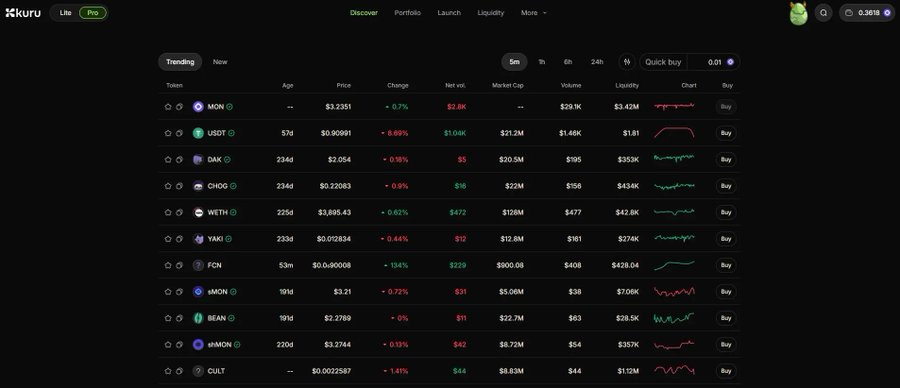
Source: Kuru
Kuru is a fully on-chain order book exchange on Monad, designed to become a trading hub. Kuru leverages the scalability of the Monad EVM to enable on-chain order book trading. Kuru not only utilizes a centralized limit order book (CLOB) but also incorporates AMM liquidity to ensure smooth trading even when liquidity is low in certain markets.
Kuru offers two modes: Lite and Pro. In Pro mode, users can trade different tokens and provide liquidity through the order book. In Lite mode, users can easily use order book liquidity to trade tokens through a simple exchange interface.
In July 2025, Kuru successfully raised $11.6 million from Paradigm, Electric Capital, and Credibly Neutral. Users can now try out simple swaps in the Lite mode of the testnet, explore the Pro mode trading interface, and even experience providing liquidity to the order book.
2.4 Others
Other notable projects in the Monad ecosystem include (FYI, protocols not covered in Section 2.4 are discussed in the next section):
Pledge
- Kintsu : A liquidity staking protocol where users can stake MON and receive sMON in return.
- Magma : A liquid staking protocol where users can stake MON to mine gMON. The protocol offers MEV-enhanced yields and utilizes Distributed Validator (DV) technology, enabling multiple participants to share the responsibilities of a validator node.
Spot DEX
- Crystal : An on-chain order book (CLOB) decentralized exchange where all trades are processed directly on-chain through smart contracts.
- Capricorn : Capricorn combines oracle-based private pools and CPMM/CLMM liquidity pools, aiming to combine the efficiency of CLOB with the composability of AMM.
- Monday Trade : A decentralized exchange (DEX) that provides users with a user experience similar to that of a centralized exchange (CEX) through a hybrid CLOB/AMM architecture, supporting trading of multiple tokens.
Perpetual Contract DEX
- Narwhal Finance : A Monad-based perpetual order book decentralized exchange that supports the use of aprMON as collateral and supports trading of synthetic assets such as stocks, indices, and foreign exchange.
- Perpl : A decentralized perpetual futures exchange based on CLOBs, built on the scalability of Monad. In May 2025, the project raised $9.25 million from Dragonfly, Ergonia, and Brevan Howard.
Aggregator
- Mace : A Monad-native DEX aggregator that routes transactions between multiple DEXs to find the optimal transaction path.
Borrowing
- Townsquare : A lending protocol in the Monad ecosystem, a finalist for Monad Madness.
- Modus : Positioned as an on-chain prime broker, Modus is the native lending protocol within the Monad ecosystem. Modus not only provides simple lending services but also offers modular features such as vaults and delta-neutral strategies. The project has received investment from Yzi Labs.
- Curvance : Users can use a variety of assets within the Monad ecosystem as collateral to obtain loans on Curvance.
New DeFi :
- Timelock : A protocol built on Uniswap V3 liquidity, offering exchange and trading functionality, along with a margin trading experience with no liquidation. Future plans include additional services such as futures, options, and meme tokens.
- Touch Market : A protocol that offers a new trading experience where users can set a price and timeframe on a chart and profit if the price “touches” that level. It offers an intuitive investment interface and stands out for its trading capabilities with up to 1,000x leverage.
Prediction Market
- Opinion Labs : One of the most popular prediction markets in the Monad ecosystem, it has received $5 million in seed round funding from YZi Labs, Animoca, and Amber.
- Narrative : A prediction market designed to allow users to trade or invest in assets based on narratives and emerging trends.
- Hyperthesis : Although not much information has been released yet, the project appears to be developing a prediction market within the Monad ecosystem.
Trading Terminal/Robot
- MevX : A multi-chain trading platform focused on meme and alpha tokens. It offers features like sniping and copy trading, and plans to support the Monad mainnet.
- Mona Trading Bot : A trading bot built specifically for the Monad ecosystem.
Meme Coin Launchpad
- Nad.fun : A meme distribution and trading platform with a simple interface similar to pump.fun that anyone can use easily.
game
- Lumiterra : A multiplayer open-world survival-building game where players can explore the world through activities like gathering, crafting, combat, and farming.
- Omnia : A game native to Monad that combines adventure and pet-based combat gameplay.
- LootGo : A mobile app that allows you to earn money while walking, providing a gamified experience through gameplay similar to Pokémon GO.
NFT
- Poply : An NFT marketplace focused on the Monad community.
RWA
- Zona : Supports the issuance and trading of tokenized real-world assets or synthetic assets, which can also be used as collateral for loans.
- Block Street : Builds on-chain execution and lending infrastructure for tokenized stocks, providing an RFQ system and risk engine. In October 2025, the project raised $11.5 million from investors including HackVC and DWF.
other
- Accountable: A real-time financial verification protocol that allows companies, protocols, and stablecoins to share transparent asset and liability information while maintaining privacy.
3. Monad official blog featured projects
Monad has published five articles on its official blog introducing several projects that have gained significant attention due to their inclusion on the official Monad platform. Here are some detailed introductions to these projects:
3.1 Fortytwo
Fortytwo is a decentralized AI network built on Monad. It operates by running multiple small language models (SLMs) simultaneously on consumer-grade hardware and combining their outputs through a consensus process to generate a final inference result. In short, Fortytwo aims to build a more powerful AI system by connecting multiple small models.
The use of multiple smaller SLMs instead of a single large language model (LLM) is not new. This approach has been widely used in AI research. For example, autonomous driving systems are typically not built from a single large AI model, but rather from multiple specialized submodules that handle specific tasks, forming a more complete system.
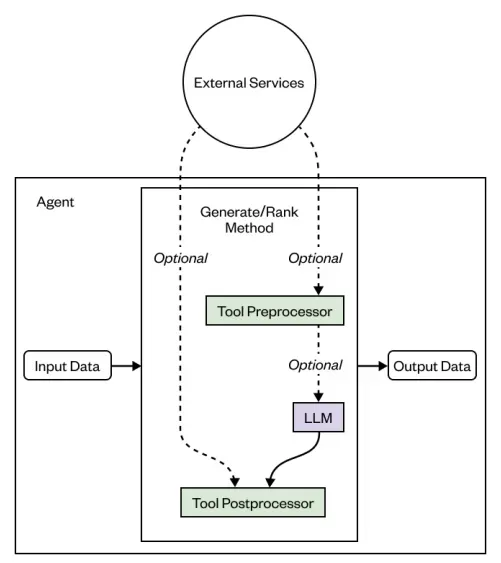
Source: Fortytwo White Paper
Fortytwo's operating principle is relatively simple. When a user sends a query to the network, participating nodes independently generate answers and evaluate each other's responses. The highest-scoring answer becomes the final consensus result. To ensure fairness, all answers are encrypted before submission and decrypted afterwards. Furthermore, to prevent Sybil attacks, nodes must stake a certain amount of tokens to participate. Monad is used as a coordination layer for settlement and reward distribution.
In March 2025, Fortytwo successfully raised $2.3 million in pre-seed funding from Big Brain Holdings, CMT Digital, EV3, Chorus One, and Mentat Group, allowing anyone with a decent home desktop computer to run a node.
As of the testnet stage, there are 739 active nodes in the network. For users interested in the Monad AI ecosystem, running a Fortytwo node after the Monad and Fortytwo mainnet launch will be a great experience.
3.2 Multisynq
Multisynq aims to build a new internet protocol for real-time synchronization. Currently, there are no standardized protocols for real-time synchronization, so applications like game servers and video conferencing tools must build their own solutions from scratch. In a centralized client-server architecture, the server is responsible for all computations, creating a single point of failure.
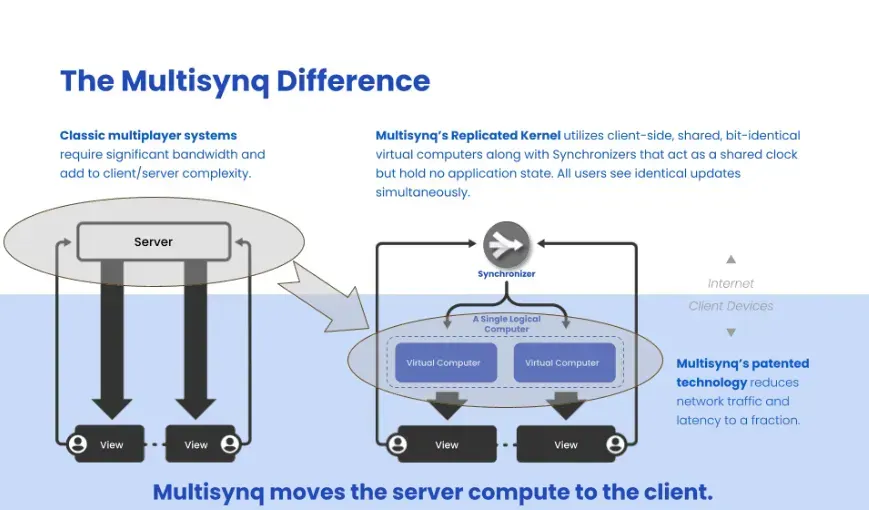
Source: Multisynq
Multisynq solves this problem by eliminating a server-centric architecture. Instead, each user's device executes application logic locally, while sync nodes within the Multisynq network coordinate. Sync nodes do not store data and cannot read the contents of encrypted messages; they are solely responsible for managing synchronization.
The real-time synchronization protocol developed by Multisynq fills a critical gap in the modern internet. When combined with blockchain, it can help build a truly decentralized network. This could one day make it possible to run large-scale applications like MMORPGs (massively multiplayer online role-playing games) supporting hundreds of thousands of players, or mapping services powered by real-time traffic data for millions of users. Multisynq serves as the synchronization layer in this decentralized internet, and plans to integrate Monad Blockchain to handle synchronization state and registries.
In April 2024, Multisynq raised $2.2 million in seed funding from Manifold Trading and Republic Capital. In February 2025, it raised $350,000 in a community funding round held by Echo. Users can currently run synchronized nodes and earn points.
3.3 Likwid
Likwid is a Monad-based DeFi protocol that combines automated market makers (AMMs) and lending functionality into a single system, allowing users to provide liquidity, borrow other assets, or open long and short positions on a single platform. Likwid's most notable feature is that it achieves these functions without relying on centralized exchanges, oracles, or counterparties.
Traditionally, opening a short position in a new token using DeFi protocols has been difficult. Users need to deposit collateral into a lending protocol, borrow the token, and then sell it. However, new tokens often lack oracle data or are not supported by lending protocols. Even if supported, liquidity is often low.

Source: Likwid
In Likwid, the liquidity pool itself acts as both a market and a lending platform, acting as a counterparty. Liquidity providers not only provide liquidity and earn fees like in AMM DEX, but also act as lenders and derivatives liquidity providers at the same time.
For example, in the MON/LIKWID liquidity pool, users can deposit MON as collateral and short LIKWID in one step. This process involves both borrowing and selling LIKWID tokens.
Once the Monad mainnet is launched, users will be able to perform basic operations on Likwid, such as token swaps, liquidity provision, and lending, and open long or short positions on new tokens to seize trading opportunities in the early ecosystem.
3.4 Clober
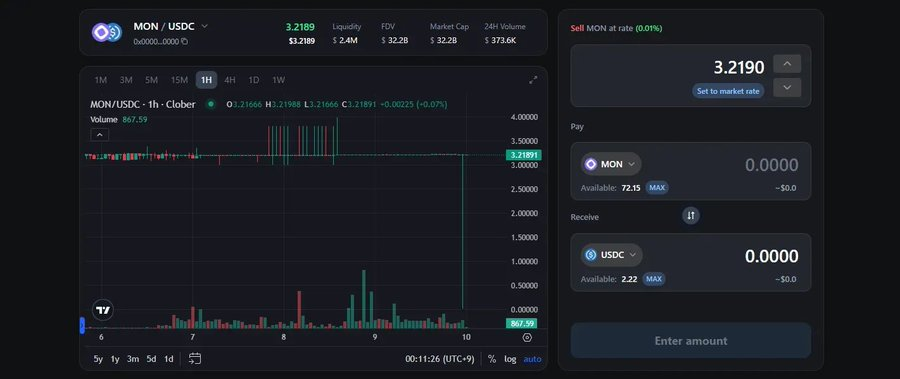
Source: Clober
Clober is a fully on-chain order book decentralized exchange (DEX) built on Monad. In addition to Monad's scalability, the protocol also introduces its unique LOBSTER (Limit Order Book with Efficient Order Matching Based on Segment Trees) mechanism, enabling efficient and gas-efficient order matching.
Building an on-chain order book on the EVM presents many technical challenges. For example, when a user places a buy order, it must be matched sequentially with multiple sell orders. Processing these operations in a for loop or similar structure consumes a significant amount of gas. LOBSTER solves this problem through deferred execution: each sell order covers a specific price range, and the system determines whether to match the buy order based on the size of the order. The seller then settles the trade.
On-chain order books are typically inefficient for large market orders that require scanning multiple price levels. LOBSTER uses a tree-based data structure to search only price levels where there are actual orders, improving performance and gas efficiency.
Through these innovations, Clober achieves AMM-level efficiency and centralized exchange (CEX)-level precision within on-chain constraints. Leveraging the scalability of Monad, it builds a sophisticated architecture capable of rivaling the performance of centralized exchanges. Users can trade tokens through the order book, place limit orders, and provide liquidity directly on the Clober platform.
3.5 Drake
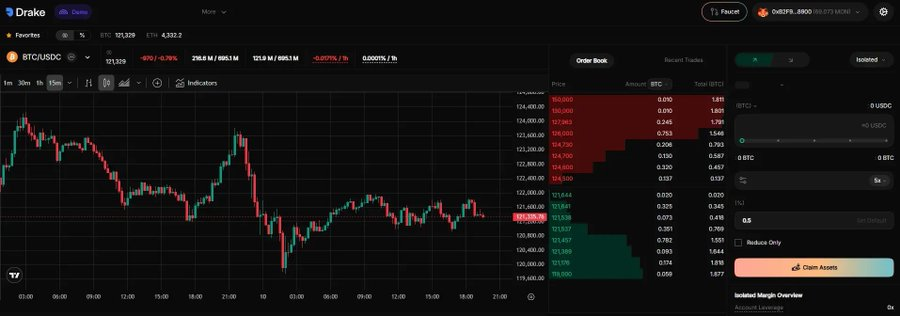
Source: Drake
Drake is a fully on-chain perpetual contract decentralized exchange (DEX), built on Monad, designed to deliver CEX-level performance while retaining the transparency and composability of DeFi. Drake's order book, matching engine, risk engine, and treasury all run on-chain.
Drake leverages the scalability of Monad to bring every component of its order book fully on-chain. Its parallel execution and low transaction costs enable it to efficiently match large numbers of orders and update state, enabling a true on-chain perpetual contract DEX.
Drake also stands out for its hybrid order book model, which primarily uses on-chain liquidity but can draw on AMM liquidity when order book liquidity is insufficient, thus ensuring deeper liquidity overall.
Drake has not raised venture capital funding and adopts a community-driven approach, which is becoming a popular trend among new perpetual contract DEXs. Monad users can already try Drake on the testnet.
3.6 Celeris
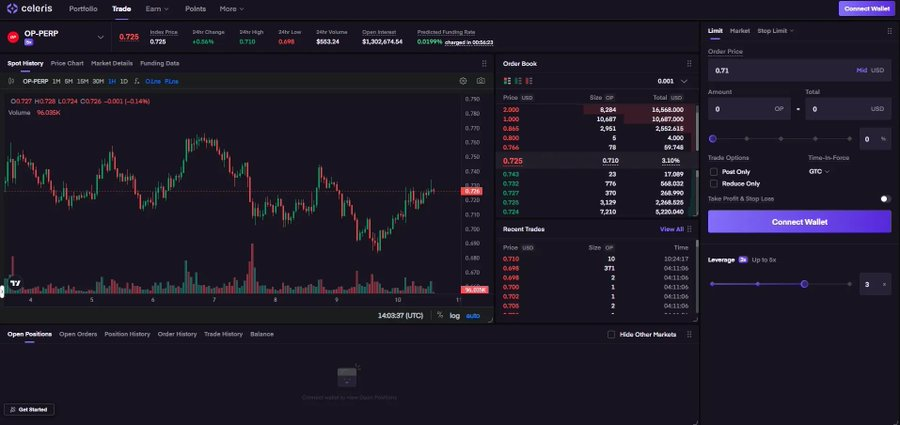
Source: Celeris
Celeris is a trading platform based on a new order book called PLOB (Parallelized Liquidity Order Book). In the CLOB system, liquidity is fragmented across individual markets, while in PLOB, a shared liquidity pool supports all markets simultaneously, significantly improving capital efficiency.
Because PLOB provides deeper liquidity than CLOB, traders experience less slippage. This model is more beneficial for liquidity providers because the same total value locked (TVL) can be distributed across more markets, resulting in higher overall fees.
Implementing PLOB requires real-time management and synchronization of the states of many markets, which is extremely complex on-chain. However, Monad's parallel EVM and MonadDB enable it to process transactions in parallel and efficiently manage multiple markets, providing a perfect environment for running PLOB.
Users can deposit Monad testnet tokens into Celeris to trade perpetual contracts across multiple markets, and also try out liquidity provision and lending features.
4.Hackathon winning projects
Monad is known for its strong community and support for early-stage projects in the ecosystem. Through various accelerator programs and hackathons, Monad provides resources and exposure to many new teams.
While most of the teams involved in these projects are still in their early stages, the ones that won awards at Monad’s official events are definitely worth keeping an eye on. Let’s take a quick look at some of them.
4.1 Monad Founder Residency Program
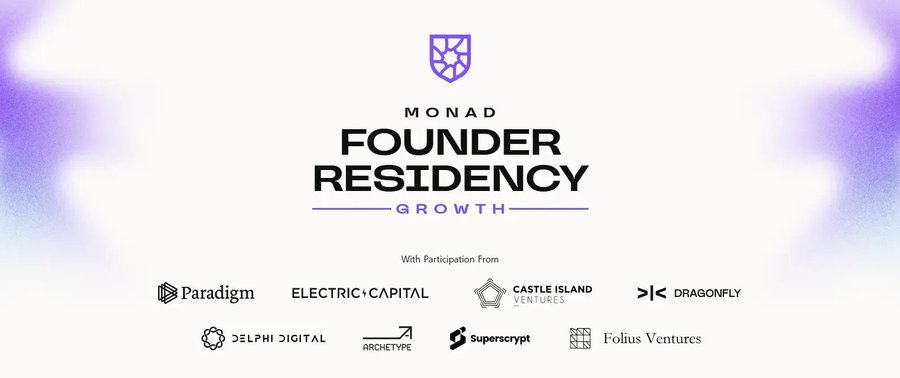
Source: Monad
The Monad Founder Residency is a three-week sprint program for early-stage crypto startups building on the Monad blockchain ecosystem. At the end of the three-week sprint, participating teams will have the opportunity to present their projects to global venture capital firms at a Demo Day. The program provides growth activities, user retention strategies, mentorship, and network support to help startups achieve scale across multiple dimensions.
So far, the program has held two rounds, with a maximum of ten projects selected in each round. The following is a brief introduction to the selected projects:
First issue
- Symphony : Helps users optimize trading strategies and explore investment opportunities across different networks through the Symphony AI agent.
- Chog NFT : An NFT project based on Monad’s mascot character Chog, which has received strong support from the community.
- Meow Finance : A Monad-based treasury protocol that tokenizes locked treasury assets into NFTs, making them available for use elsewhere.
- Zona Finance : A platform that brings RWAs onto the chain, focuses on real estate investments, and allows users to borrow stablecoins using these assets as collateral.
- Monorail : A native Monad exchange aggregator that allows users to trade assets via the optimal route.
- The Vape Labs : A DePIN project built around smart e-cigarette devices, it uses a healthy e-cigarette profit model.
- Rayvo : A Web3 smart glasses project that adopts a wear-and-earn model. Users can earn tokens by wearing glasses and providing POV data that can be used for AI or on-chain systems.
- Fans3 AI : A platform that lets creators build and operate emotionally intelligent AI characters that can interact with fans and generate revenue.
Second issue
- TypeX Keyboard : A project to create an AI and Web3-friendly smart keyboard that connects the typing interface directly to AI and Web3 services.
- Sonzai Labs : A studio that combines Web3, AI, and games to create immersive experiences, developing mini-program games on Telegram.
- Buzzing App : An opinion-based prediction market where users can bet on questions like “Will ETH exceed $10,000 by December?”
- Agra : A protocol that allows users to trade, borrow, and invest using assets across multiple networks as collateral.
- SEER : A trading platform that integrates market insights, social trends and trading tools.
- Yap.market : A marketplace connecting content creators (yappers) and projects.
- Kizzy : A Monad-based social media prediction platform that allows users to bet on metrics such as YouTube video views or influencer follower growth.
- Rug Rumble : A Monad-based GameFi project where two players bet memecoin and battle in a card game.
- CULT : A memecoin exchange that makes it easy to launch and trade new memecoins on Monad, with a reputation system for selective pre-sales.
- Mu Digital : A platform for investing in tokenized real-world assets (RWA) in Asia, backed by UOB, Signum Capital and CMS.
- Levr.Bet : A Monad-based, on-chain leveraged sports betting platform. As prediction markets heat up, LEVR.BET stands out by offering up to 5x leverage.
4.2 Monad Madness

Source: Monad
Monad Madness is a global pitch competition for developers and startups, designed to discover and support innovative projects within the Monad ecosystem. The competition offers a $1 million prize pool and, through partnerships with multiple venture capital firms, provides up to $60 million in potential venture capital investment opportunities.
Monad Madness has so far been held in New York, Bangkok, and Hong Kong. Let's take a look at the top three events from each event.
New York
- EarnOS (No. 1)
EarnOS is the first application built on the blockchain payment orchestration protocol OS (OpenSystem). It is a rewards and advertising platform designed to address the inefficiencies of the traditional advertising market. While traditional advertising generates high click-through rates and impressions, the actual impact is unclear, and consumers are treated as mere targets. On EarnOS, brands can directly assign tasks to users, who receive instant rewards such as USDC upon completion. Users can also register on the EarnOS platform and participate in various activities to earn points.
- ChainPro (No. 2)
ChainPro is an on-chain trading terminal rebranded from SauceGG. It allows users to trade a variety of assets across multiple networks on a single platform. With its excellent UI/UX and zero transaction fees, ChainPro makes memecoin trading more convenient. It plans to support the Monad mainnet, making it even easier to trade assets, including meme tokens from the Monad ecosystem.
- LEVR.BET (No. 3)
Meet the second cohort of the Monad Founders in Residence Program.
Bangkok
- RareBetSports (No. 1)
RareBetSports is a Web3-based sports betting prediction market and a Monad-native decentralized application (dApp). Its unique feature is that users can assemble lineups of two to seven players and predict each player's performance, adding a strong strategic element.
- Kizzy (2nd place)
Meet the second cohort of the Monad Founders in Residence Program.
- SparkBall (No. 3)
SparkBall is a PC-based 4v4 sports and combat hybrid game where players need to score goals while battling against their opponents.
Hongkong
- AMMO AI (No. 1)
AMMO AI is a project building large-scale multi-agent systems on Web3. It creates a reinforcement learning environment where multiple agents can autonomously interact and learn. The project has received investments from AMBER and Samsung Next.
- GM Network (No. 2)
GM Network is developing a mobile-based AI super app that provides agent-driven chat services.
- TypeX (No. 3)
Meet the second cohort of the Monad Founders in Residence Program.
4.3 Monad evm/accathon
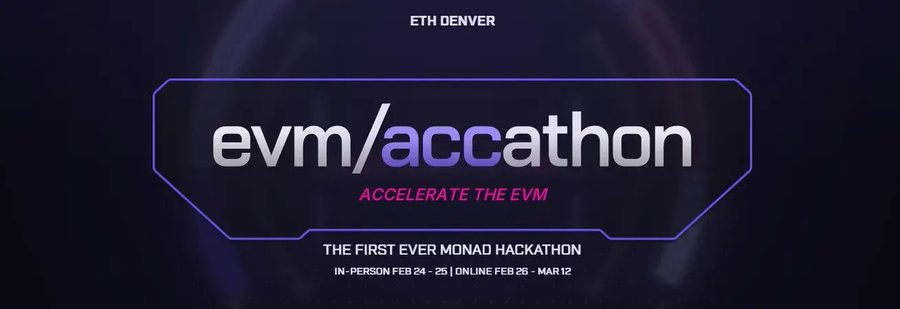
Source: Monad
The Monad EVM/ACCathon was a hybrid hackathon held during ETH Denver, with both in-person and online tracks. The event focused on innovative solutions leveraging Monad's high-performance EVM architecture. Five projects were awarded at the EVM/ACCathon:
- KiSignals (No. 1)
Developed by the KiFi team, KiSignals is an alpha-call aggregator on Telegram that allows users to trade tokens based on social data. KiFi is a Monad-based mobile trading and SocialFi platform, and users can currently sign up for the beta waitlist.
- StageFun (2nd place)
Developed by the Blocklive team, StageFun is an event crowdfunding platform.
- OwnPay (3rd place)
OwnPay is a payment service that enables instant on-chain transactions between devices.
4.4 Monad Mach 2: NFT

Source: Monad
Monad Mach 2 is an accelerator program designed for NFT builders in the Monad ecosystem, offering one-on-one mentoring, workshops, and masterclasses. A total of 80 NFT projects were selected, and the full list can be found in the official Monad Eco X post . Here are some notable projects:
- Monad Nomads NFT : One of the early OG NFT projects in the Monad ecosystem, started in February 2023. Obtained whitelist qualification through various community activities.
- Monadverse : An NFT series centered around Monanimals characters, released in chapters. It collaborates with over 40 other projects and is one of the core NFT projects of the Monad ecosystem.
- Skrumpeys : A cute pet-themed NFT collection, including 500 Skrumpets NFTs. The team also announced a rare DN NFT collection, limited to 135 pieces.
- lil chogstars , Chog : Popular PFP projects in the Monad ecosystem, all inspired by the Chog character.
- Breath of Estova : A 2D MMORPG built on Monad that allows players to use NFTs from other projects as in-game skins.
- Purple Frens : An NFT series issued by Alloca, a monad-based token issuance platform. It has raised $2.5 million from CMS and Cogitent. Holders are expected to receive benefits such as revenue sharing, pre-sale access, and platform perks.
4.5 Monad Momentum
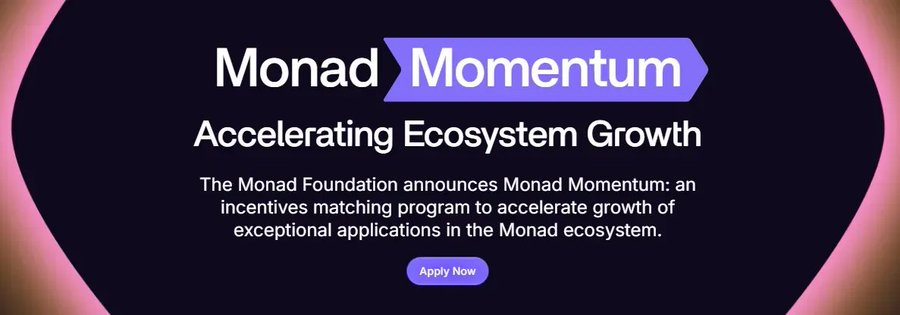
Source: Monad
Monad Momentum is an incentive program designed to accelerate early-stage ecosystem growth. Unlike traditional grant systems, it utilizes a matching incentive model. This means that when selected projects invest their own resources, the program matches their additional support.
In the past, many L1 and L2 ecosystems operated through grant programs or ecosystem funds but failed to establish meaningful dApp ecosystems. However, Monad has learned valuable lessons from its past programs, such as the Founder Residency Program, the EVM/Accelerator, and Monad Madness. Building on these experiences, Monad aims to reward projects that make tangible contributions to the ecosystem and foster a sustainable, high-quality dApp environment after the mainnet launch.
The selection criteria for Monad Momentum are very strict:
- Projects must already be running on the Monad testnet or be ready to deploy to mainnet soon.
- Projects must have completed or scheduled a safety audit.
- Projects must demonstrate the sustainability of their operations.
- Projects must have meaningful user metrics.
The full list of Monad Momentum’s selected projects has not yet been announced, but since MON incentives will be distributed to users of these dApps after the mainnet launch, it is worth keeping a close eye on Monad Momentum’s updates.
Final Thoughts
From Bitcoin and Ethereum to the countless L1 and L2 networks that followed, some have succeeded, while others have fallen short. So, what determines success? While technology and user or developer experience are important, the most crucial factor is building a vibrant and sustainable dApp ecosystem. Monad is no exception.
Ethereum makes smart contracts possible. Solana supports high-performance applications that Ethereum can't handle. Monad's greatest strength is its "high-performance EVM," and its success depends on whether it can launch enough demanding, performance-intensive EVM applications on it to attract users.
Looking at the current monad ecosystem, we can draw several key insights:
- Projects leveraging Monad's performance : Many existing dApps in the ecosystem, such as the order book DEX and the memecoin launchpad, leverage Monad's parallel execution capabilities and MonadDb functionality. Interestingly, while other ecosystems are primarily dominated by AMM-based DEXs, Monad's scalability makes it possible for more CLOB-based (on-chain order book) DEXes. Beyond trading, sectors like social networking, gaming, and streaming are also likely to flourish. Hopefully, we'll see the emergence of killer apps in these areas after the mainnet launch.
- Lack of Stablecoin and Real-Wa Asset (RWA) Projects : The stablecoin and real-world asset (RWA) sectors have become core to the crypto industry and are among the few areas that have achieved product-market fit. While high scalability isn't critical to these sectors, they are crucial for the foundational work of any blockchain ecosystem. Currently, Monad lacks strong players in this category. Given its strength in the trading space, Monad should also develop a strong stablecoin and RWA ecosystem. The Monad Foundation's acquisition of Portal in July is an exciting step in this direction.
- Competition among liquidity staking protocols : Even before the mainnet launch, several major liquidity staking protocols, including aPriori, FastLane Labs, Magma, and Kintsu, were preparing to launch. While their unique and differentiated advantages are compelling, an excessive number of liquidity staking options could fragment liquidity and impact user experience. It will be interesting to see how this competitive landscape evolves after the mainnet launch.
The long and long journey of monads has just begun. For all of you embarking on your first monad adventure, I hope this guide will help you explore the monad ecosystem with confidence.
- 核心观点:Monad主网上线将推动高性能EVM生态爆发。
- 关键要素:
- 并行EVM技术实现万级TPS。
- 生态已覆盖293个原生dApp。
- 流动性质押协议获巨额融资。
- 市场影响:或重塑公链竞争格局。
- 时效性标注:中期影响


